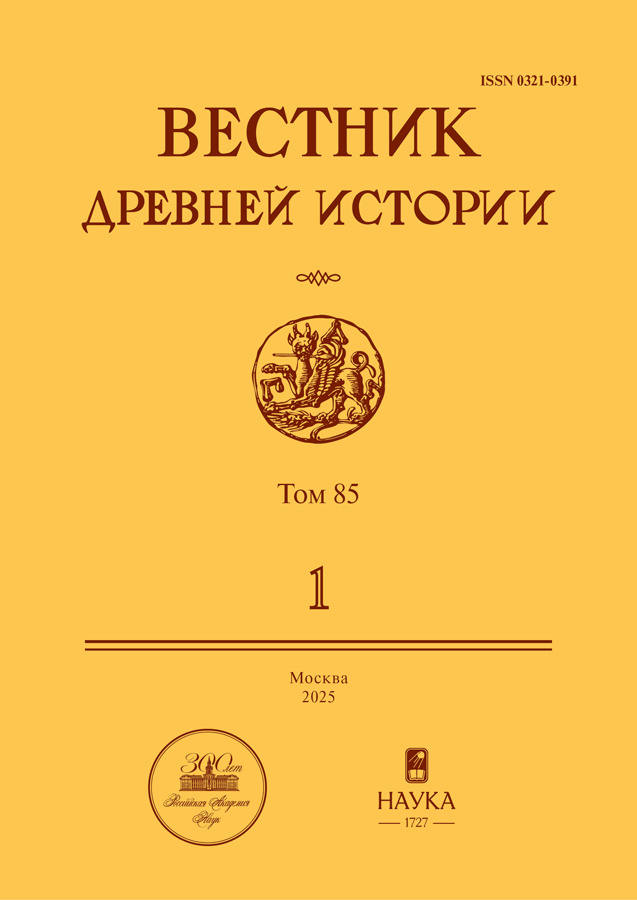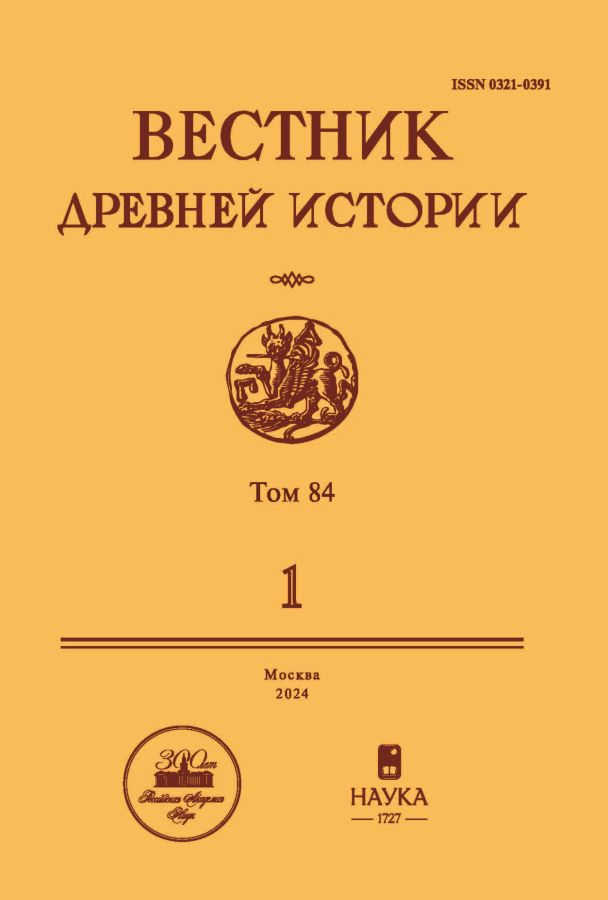Том 84, № 1 (2024)
Статьи
Царь Рамсес и Бактрия. Об одном мотиве позднеегипетского историописания
Аннотация
В статье рассматривается комплекс сообщений античной традиции, в которых идет речь о завоевании или о попытке завоевания египтянами Бактрии (Diod. I. 46–47; Tac. Ann. II. 60. 3; Strabo XVII. 1. 46), сообщение Манефона Севеннитского о широких завоеваниях царя Сетоса-Рамессеса (I) (Manetho. Frg. 50 = Ios. C. Ap. I. 15. § 98– 102), а также текст иероглифической «Стелы Бентреш», отражающий взаимодействие Египта при царе Рамсесе с далекой азиатской страной Бахтан. Все эти источники отражают фиванскую традицию реминисценций о войнах царей XIX династии: Сети I (Сетос-Рамессес (I) Манефона), восстановившего сферу египетского влияния в Азии после наступления хеттов, и Рамсеса II (Осимандия Гекатея Абдерского и Диодора, Рамсес «Стелы Бентреш»), не сумевшего развить этот успех и заключившего компромиссный мир с хеттами. Отчасти их образы контаминировались (царь Рамсес Тацита), и, видимо, к ним стягивались реминисценции обо всем наступлении Египта Нового царства в Азию (не только при XIX, но и при XVIII династии). Замещение в этой традиции исторического Хеттского царства Бактрией произошло в результате не только забвения его реалий и трансформации его обозначения, но, видимо, и общего представления египтян о том, что противником их страны на данном этапе ее истории было некое необычайно удаленное крупное государство, долго не входившее в состав межрегиональных азиатских держав I тыс. до н. э.
 5-26
5-26


Повеления Дария I и Ксеркса в корпусе царских надписей Ахеменидов
Аннотация
В статье исследуется вопрос о роли повелений Дария I и Ксеркса в функционировании правовой системы Персидской империи Ахеменидов. Отмечается, что средствами социально-политического и экономического регулирования в Ахеменидской империи, наряду с местными политико-правовыми традициями, были непосредственно царские распоряжения, которые исходили от самого царя и его канцелярии. В качестве основного источника информации по данной теме рассматриваются трилингвальные царские надписи Ахеменидов. В самих этих текстах присутствуют ссылки на повеления царя, а терминологический анализ, охватывающий соответствующую лексику надписей на основных трех языках (древнеперсидском, эламском и аккадском), позволяет прийти к определенным выводам в отношении функционирования правовой системы Ахеменидов в целом. Рассмотрение материала надписей позволяет утверждать, что царские повеления, упомянутые в них, могут быть разделены на три группы (царские указы, царские приказы и прокламации). В царских надписях Ахеменидов приказами могут считаться распоряжения, отданные царем своим военачальникам или армии, указы же не имеют конкретного адресата и носят более общий характер. Если же говорить об особом виде царских повелений, таких как прокламации, то они обращены ко всему населению Ахеменидской империи.
 27-46
27-46


К интерпретации «Махабхашьи»
Аннотация
Статья посвящена классическому памятнику древнеиндийской лингвистики – комментарию Патанджали на грамматику санскрита Панини. Автор склоняется к датировке Панини рубежом IV–III вв. до н. э. Часто приводимые аргументы для датировки Патанджали серединой II в. до н. э. не кажутся убедительными. Упоминание похода греко-бактрийского царя в долину Ганга является не более чем terminus post quem. Есть основания думать, что «Махабхашья» была создана не ранее начала нашей эры. Особое внимание в статье обращено на интерпретацию фрагмента, в котором упоминается династия Маурьев. Автор полагает, что слова о Маурьях, которые изготавливают изображения богов с целью наживы, свидетельствуют о знакомстве Патанджали с циклом легенд о Чанакье и Чандрагупте, а возможно, и с традицией, отраженной в «Артхашастре».
 47-54
47-54


Аристотелево определение олигархии и олигархические режимы в Афинах V–IV вв. до н. э.
Аннотация
В «Политике» Аристотеля содержится нетрадиционное и даже неожиданное определение олигархии, представляющее ее, в отличие от общепринятого понимания (исходящего из прозрачной этимологии самого термина) не как «власть немногих», а как «власть богатых». Соответственно один из главных признаков олигархий для философа – имущественный ценз. В статье рассматривается, как соотносилась с этими теоретическими выкладками политическая практика афинских олигархов. Обнаруживается, что две фазы олигархического движения в Афинах (конец V в. до н. э. и конец IV в. до н. э.) принципиально различаются именно в этом отношении. В первом случае вопрос о цензе даже не поднимался, был применен совершенно иной принцип – создание гражданского коллектива, ограниченного численным лимитом (5000 в 411 г. до н. э., 3000 в 404 г. до н. э.). Во втором же случае исходили из идеи ценза в чистом виде (2000 драхм в 322 г. до н. э., 1000 драхм в 317 г. до н. э.). Таким образом, олигархические режимы первого периода ближе к традиционному определению олигархии, олигархические режимы второго периода ближе к Аристотелеву определению (они и создавались под несомненным идеологическим влиянием перипатетической школы).
 55-76
55-76


Античное межевание таманско-ольвийского типа в районе Нижнего Поднепровья
Аннотация
В статье на основе общедоступных данных интернет-сервиса Google Earth показывается, что наибольшая площадь античного межевания в Северном Причерноморье приходилась на район Нижнего Поднепровья. Наблюдающееся здесь межевание очень близко по своим внешним признакам к землеустройству, давно известному в округе Ольвии. В целом это межевание может быть отнесено к нелинейному межеванию таманско-ольвийского типа. В статье обосновывается предположение, что межевание в Нижнем Поднепровье связано с земледелием, которым занимались жители скифских поселений IV – первой трети III в. до н. э. Вместе с округой Ольвии район Нижнего Поднепровья образует сдвоенный центр однотипного землеустройства со значительным земледельческим потенциалом. Другим таким сдвоенным центром межевания, но меньшего масштаба, являлся Боспор вместе с районом Средней Кубани.
 77-106
77-106


Бокх глазами Саллюстия: штрихи к портрету
Аннотация
В статье рассматривается изображение мавретанского царя Бокха в Bellum Iugurthinum Саллюстия. Первоначально он выступает как марионетка Югурты и собственных советников, подкупленных нумидийским царем, но вскоре начинает действовать вполне самостоятельно, не являясь надежным партнером ни для римлян, ни для нумидийцев. В центре внимания Саллюстия бесконечные колебания Бокха (предать Югурту или римлян) и перемена им решений, которые, однако, не всегда сопровождаются какими-либо действиями. Римский писатель называет Бокха bаrbarus и обвиняет его в fides Punica, тогда как в адрес Югурты такие обвинения не звучат. Саллюстий утверждает, что цари часто вступают в противоречие с самими собой (Iug. 113.1), но Бокх остается вполне верен себе, поскольку суть его характера, как он показан у Саллюстия, именно в противоречиях, которые и отражаются в его бесконечных колебаниях и перемене решений.
 107-118
107-118


Новая Троя Нерона: рецепция Вергилия и Горация в «Латинской Илиаде»
Аннотация
В последние годы стал заметен рост интереса исследователей к малой эпической поэме, известной как «Латинская Илиада». Подробное рассмотрение связи этого произведения с «Энеидой» Вергилия и лирикой Горация позволяет сделать вывод, что автора «Латинской Илиады» в первую очередь интересовали темы, актуальные для времени правления Нерона: взаимосвязь между Римом и Троей, а также вопрос проявления милосердия к поверженному врагу. Последняя тема кажется особенно актуальной для своего времени в связи с трудами Сенеки «О гневе» и «О милосердии».
 119-130
119-130


Публикации
Клад селевкидских бронзовых монет из Южного Дагестана
Аннотация
В статье публикуется клад из 46 селевкидских бронзовых монет, обнаруженный в 2021 году на юге Дагестана. Основу комплекса составляют 43 бронзовые монеты Антиоха IV, отчеканенные на монетном дворе Антиохии на Оронте. Все они относятся к так называемой «египтизированной» серии, выпускавшейся в период с осени 169 до осени 168 г. до н. э. Кроме них клад включает две монеты Антиоха IV из Селевкии на Тигре. Уникальной особенностью рассматриваемого комплекса является наличие в нем монеты селевкидского узурпатора Тимарха, вероятно отчеканенной в 162–160 гг. до н. э. Скорее всего клад был сформирован за пределами Кавказской Албании и демонстрирует состав денежного обращения восточных областей государства Селевкидов во второй половине II в. до н. э.
 131-148
131-148


В музейных собраниях мира
Шесть остраконов с «Поучением Хети» из собрания ГМИИ им. А.С. Пушкина
Аннотация
Статья представляет собой первую публикацию шести древнеегипетских остраконов из собрания ГМИИ им. А. С. Пушкина (I,1б 334, 340, 344, 347, 348, 362), которые содержат фрагменты литературного произведения «Поучение Хети» («Сатира на профессии»). Остраконы первоначально находились в коллекции первого русского египтолога Владимира Семеновича Голенищева. Они датируются временем 19– 20 династии и происходят, вероятно, из Дейр эль-Медины.
 151-162
151-162


Из истории науки
Египетское рабство в раннем творчестве М.А. Коростовцева
Аннотация
Главная тема статьи – раннее научное творчество академика М. А. Коростовцева (1900–1980), пришедшего окончательно в историческую науку лишь ко второй половине своей жизни. В довоенный период историк успел написать сравнительно немного работ, среди которых особую роль играет кандидатская диссертация, посвященная египетскому рабству периода XVIII династии. Ее текст интересен тем, что фиксирует новую фазу развития советской историографии древности, при которой именно рабовладельческая теория считалась проявлением марксистско-ленинского характера советской науки. Научным руководителем Коростовцева был В. В. Струве, поэтому многие моменты в диссертации отражают его понимание истории древневосточных обществ. Тем не менее Коростовцев не был только учеником Струве, поскольку он проявлял большую осторожность в работе с источниками и большую аккуратность в итоговых выводах. Он не обнаружил упоминаний большого числа рабов при XVIII династии ни среди военнопленных, ни в сфере частновладельческого рабства, кроме нескольких исключений, которые не обязательно означали общее широкое распространение рабовладения. В этом отношении можно говорить о Коростовцеве как о последователе Ю. Я. Перепёлкина, в том числе потому что в эти же годы он защищал взгляды Перепёлкина в своих письмах к А. Б. Рановичу: согласно Коростовцеву, на деле марксистская теория быстро придет к исчерпанию, если будет спешить с обобщениями до того, как сможет удостоверить их историческими фактами. Тем не менее в собственной работе Коростовцев смог найти лишь неустойчивый баланс между заявленным обобщением о рабовладельческом Египте и свидетельствами источников об относительно скромном развитии рабства при XVIII династии.
 163-177
163-177


Научная жизнь
«Ломоносовские чтения» на кафедре древних языков и кафедре истории древнего мира МГУ имени М.В. Ломоносова (Москва, 7, 11 апреля 2023 г.)
 194-196
194-196


Ежегодная конференция «Цивилизации древнего Ближнего Востока и античности: историческая динамика общего и особенного» (Москва, 21–22 июня 2023 г.)
 197-204
197-204


Всероссийский круглый стол «Плиний Старший и его “Естественная История”: К 2000-летию со дня рождения» (Москва, 13–14 октября 2023 г.)
 205-210
205-210


Юбилейная конференция «XXV Жебелёвские чтения» в Санкт-Петербургском государственном университете (Санкт-Петербург, 25–27 октября 2023 г.)
 211-219
211-219


Критика и библиография
V. Dasen, Th. Daniaux (éd.). Locus Ludi: quoi de neuf sur la culture ludique antique? (Pallas: Revue d’études antiques, 119). Toulouse: Presses universitaires du Midi, 2022. 530 p. ISBN: 978-2-8107-1208-3
 178-183
178-183


Римский императорский двор как политический и социокультурный феномен. (B. Kelly, A. Hug (eds.). The Roman Emperor and His Court, c. 30 BC – c. AD 300. Vol. 1: Historical Essays. Cambridge: Cambridge University Press, 2022. xix, 585 p. ISBN 978-1-316-51321-7; Vol. 2: A Sourcebook. Cambridge: Cambridge University Press, 2022. xxxvi, 295 p. ISBN 978-1-316-51323-1)
 184-193
184-193


Приложение
Осия 2 (Вступительная статья, перевод с древнееврейского и комментарий Л. Е. Когана, В. Р. Гордон и М. М. Юровицкой)
 220-256
220-256













